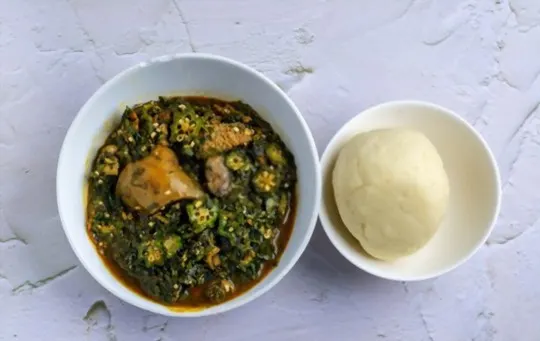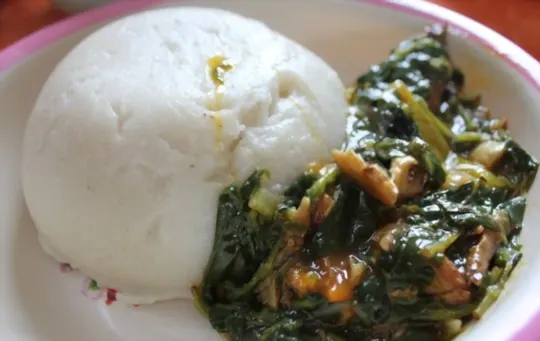Have you ever taken a bite of fufu and wondered what this starchy comfort food really tastes like?
Whether it’s the soft, smooth texture or its gelatinous consistency that gets you intrigued, there’s something about fufu that makes the taste buds lively.
In this comprehensive guide, we’ll explore all the beloved flavors of this African favorite dish – from its main ingredients to its countless variations.
You’ll learn what a traditional plate of fufu looks like in various cultures as well as discover how you can make your own flavor-filled recipes at home.
Get ready for an exciting journey into discovering all things fufu!
What is Fufu and Egusi?

Fufu and Egusi is a popular West African dish made from starchy vegetables and ground melon seeds, respectively.
Fufu is typically made using cassava, yam, or plantain that has been cooked and mashed to a thick, dough-like consistency.
Egusi on the other hand is a soup made of ground melon seeds, mixed with palm oil, spices and meat.
To break it down further:
- Fufu is a starchy dish.
- Egusi is made from ground melon seeds.
- Fufu is mostly consumed in West Africa.
- Egusi soup contains palm oil.
- Both dishes are eaten together as a meal.
- They are often accompanied by meat or fish in the traditional recipe.
When it comes to Fufu and Egusi, it’s not just about the taste but also the cultural significance behind each dish.
These meals have been passed down for generations and continue to have a meaningful place in many West Africans’ lives.
Understanding what Fufu and Egusi are can give you insight into one’s culture.
Being able to share these dishes can bring people closer together.
What Does Fufu Taste Like?

Fufu is a starchy food that is popular in West and Central Africa.
It is made by pounding cassava, yams or plantains into a smooth dough-like consistency.
Fufu itself does not have a strong taste; it is mostly used as a vehicle to scoop up soups and stews.
Its texture is thick and somewhat sticky, which many people find satisfying.
If you have never tasted fufu before, the closest comparison would be to mashed potatoes or perhaps polenta.
The taste of fufu is rather bland on its own, but it serves as an excellent complement to flavorful dishes like egusi soup or groundnut stew.
When eating fufu, take small portions and roll them into balls with your fingers.
Then, use them to scoop up the soup or stew you are eating.
As you chew, you will notice the unique texture of fufu – slightly doughy with some resistance.
Its mild flavor allows the other ingredients in your dish to shine through.
Overall, fufu’s taste is not the main attraction; rather its texture and ability to pair well with other foods make it an important part of African cuisine.
What Does Egusi Taste Like?

Egusi is a versatile seed that is commonly used in West African cuisines.
It is known for its nutty flavor and is often described as tasting like pumpkin seeds or sunflower seeds.
However, it has a unique taste that is difficult to compare to other seeds.
The taste of Egusi can also vary slightly depending on how it is prepared.
When toasted or roasted, the flavor becomes more pronounced and earthy.
In contrast, when boiled or soaked, the flavor becomes milder and slightly sweeter.
Egusi is often used in stews and soups as a thickener, much like okra or cornstarch.
Its unique taste and texture make it an excellent addition to these dishes, adding depth and richness to the flavors.
In some cultures, Egusi is also used as a base for sauces or dips.
Ground into a paste with other ingredients such as garlic, ginger, and chili peppers, it creates a delicious dip with complex flavors that can be enjoyed with bread or vegetables.
Overall, Egusi has a rich and nutty flavor profile that adds depth to savory dishes.
Its versatility allows it to be used in various cuisines beyond West Africa, making it an excellent ingredient to experiment with in the kitchen.
How to Cook Fufu and Egusi to Enhance Their Flavor
To enhance the flavor of Fufu and Egusi, there are specific cooking techniques you can follow.
These methods ensure that not only do these dishes taste delicious, but the ingredients retain their nutrients as well.
- Step 1: Begin by washing the Fufu powder thoroughly in cold water to remove any lumps.
- Step 2: In a large pot, boil some water and gradually add the Fufu powder while stirring constantly. Cook this mixture until it becomes thick and elastic.
- Step 3: Meanwhile, heat up some oil in another pot and then carefully add the ground Egusi seeds. Roast these seeds until they turn golden brown.
- Step 4: Next, add water to this mixture and let it simmer until it thickens into a smooth sauce-like consistency.
- Step 5: Combine the Egusi with the prepared Fufu dish to create a mouth-watering meal with deep flavors that’ll leave you craving for more.
When cooking both dishes, ensure that each ingredient is fresh to elevate its flavor profile.
Also, don’t be afraid of experimenting with different spices or herbs as per your preference.
Fufu and Egusi dishes are unique to African cuisine and have garnered much love worldwide.
Cooking them correctly ensures that all their traditional flavors remain intact even if you use substitutes for certain ingredients.
Additionally, they provide an exceptional dining experience when combined with other traditional African delicacies like Jollof Rice or Okra soup.
Culinary Uses of Fufu and Egusi

Fufu and Egusi are two popular dishes in African cuisine, particularly in West Africa.
These meals are versatile and have a unique taste, making them suitable for various occasions.
Here is a breakdown of how these dishes are used in culinary practices:
Fufu has the unique quality of being able to complement almost any dish with its neutral flavour profile.
It serves as a staple for many West African countries thanks to its versatility when it comes to pairing it up with different accompaniments.
Egusi’s mild nutty flavor can be brought out more by roasting the seeds before grinding them into powder form to cook along with something else like Spinach, Okra etc.
Due to the thicker consistency of Egusi soup, it can be served as a filling meal on its own.
Even though these dishes have their origins in West Africa, they can find their place among some international cuisines.
The combination of fufu and egusi is also very popular in African cuisine.
The texture of the fufu when combined with soups or stews containing egusi create an enjoyable dish that contrasts textures making it an amazing experience for food lovers.
As come across from above points, hopefully somebody might gain the culinary interest on both Fufu and Egusi in terms of flavour and versatility it got on various meals.
Where to Buy Fufu and Egusi and How to Store Them?

If you’re wondering where to buy fufu and egusi, these African ingredients can typically be found at specialty markets or African grocery stores.
You may also be able to find them online through various retailers.
When buying fufu, it’s important to choose a brand that suits your taste preferences as there are different types of fufu made from various starchy roots such as cassava or yam.
Once you’ve purchased your fufu and egusi, it’s important to store them properly to maintain their freshness.
Fufu should be kept in the refrigerator or freezer depending on how soon you plan on using it – while some brands of fufu can last for up to a week in the fridge, others may need to be frozen immediately after purchase.
Similarly, egusi seeds should be stored in an airtight container in a cool, dry place away from direct sunlight.
When it comes time to use your fufu and egusi, it’s important to follow recipe instructions carefully.
While these ingredients are versatile and can be used in a variety of dishes from soups to stews, using too much or too little can drastically impact the final outcome of your dish – particularly when it comes flavor and consistency.
In general, though, both fufu and egusi offer unique textures and flavors that make them popular choices for many African dishes.
Fufu is typically mild in flavor but has a smooth, doughy texture that pairs well with soups, stews or sauces.
Egusi seeds have a slightly nutty taste similar to pumpkin seeds and add richness and thickness when used as a base for stew.
Conclusion
Here, you have learned about Fufu and Egusi, two popular West African foods.
You now know where to buy them and how to store them.
Fufu is a starchy side dish made from yam, cassava or plantains, while Egusi is a soup made from ground melon seeds, typically served with Fufu.
Fufu can be an acquired taste due to its sticky texture, but it is worth trying as it pairs well with many savory dishes.
As for Egusi soup, it has a nutty flavor that complements the bold spices often found in West African cuisine.

What Does Fufu Taste Like? A Comprehensive Guide
Ingredients
- Fufu
- Ingredients from your selected recipes
Instructions
- Select ingredients that work well together.
- Use a recipe or method that will enhance their natural taste.
- Taste and adjust the recipe as needed to achieve the desired flavor.

Carrie is a food writer and editor with more than 15 years of experience. She has worked for some of the biggest names in the food industry, including Bon Appétit, Food & Wine, and Martha Stewart Living.
As the Editor in Chief of IntroChicago.com, Carrie oversees all of the content on the site. She also manages the team of contributing writers and editors, who help to create delicious recipes, helpful tips, and informative articles that you’ll find on the site.
A native of the Chicago area, Carrie is passionate about all things food. She loves trying new restaurants and experimenting with new recipes in her kitchen. She’s also a graduate of the Culinary Institute of America, so she knows a thing or two about food!
